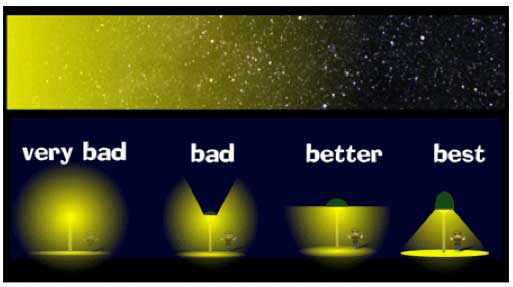Light pollution hides the beauty of the night sky. It affects our health and wildlife.
Fixing light pollution involves simple changes in how we use artificial light. Light pollution is a growing problem. It makes it hard to see stars and disrupts natural cycles. Streetlights, billboards, and even home lighting contribute. The good news? We can take steps to reduce it.
Using better lighting designs and being mindful of our light usage can make a big difference. In this post, we’ll explore ways to fix light pollution. You’ll learn how small actions can help restore the night sky. Ready to bring back the stars? Let’s dive in!
Table of Contents
ToggleIntroduction To Light Pollution
Light pollution is an often-overlooked problem. It affects our environment, health, and visibility of the night sky. This blog will help you understand light pollution, its types, and how to mitigate it.
What Is Light Pollution?
Light pollution is the excessive or misdirected artificial light. It disrupts natural cycles and obscures the stars in the night sky. It can have negative impacts on human health, wildlife, and our ability to observe celestial events.
Types Of Light Pollution
| Type | Description |
|---|---|
| Glare | Excessive brightness causing visual discomfort. Often from unshielded lights. |
| Skyglow | Brightening of the night sky over populated areas. Makes it hard to see stars. |
| Light Trespass | Unwanted or intrusive light spilling into areas. For example, a neighbor’s light shining into your bedroom. |
| Clutter | Bright, confusing, and excessive groupings of light sources. Common in urban settings. |
Understanding these types of light pollution can help us take steps to reduce it. By using appropriate lighting and being mindful of our light usage, we can protect our environment and preserve the beauty of the night sky.

Credit: www.archdaily.com
Impacts Of Light Pollution
Light pollution affects our environment in many ways. It disrupts human health, wildlife, and even our ability to see the stars. Let’s explore these impacts in detail.
Effects On Human Health
Light pollution can cause sleep disorders. Bright lights at night confuse our internal clock. This leads to trouble sleeping and health issues like stress and obesity. It can also affect mood and mental health.
Consequences For Wildlife
Wildlife suffers greatly from light pollution. Many animals rely on darkness for survival. Artificial light disrupts their natural behaviors. Birds, for example, get confused by city lights. They often crash into buildings and die. Sea turtles also struggle. Hatchlings use moonlight to find the sea. Artificial lights lead them in the wrong direction.
Astronomy And Night Sky Visibility
Light pollution hides the beauty of the night sky. Astronomers find it hard to study stars and planets. Even amateur stargazers see fewer stars. This loss affects our connection to the universe.
Assessing Light Pollution Levels
Assessing light pollution levels is crucial for creating effective solutions. Understanding the extent of light pollution helps in planning and implementing measures. This section will guide you on how to assess light pollution levels accurately.
Measuring Light Pollution
Light pollution measurement involves quantifying the brightness of the night sky. This data helps identify problem areas and track improvements. There are several methods to measure light pollution effectively.
Tools And Techniques
Various tools and techniques exist for measuring light pollution levels. One common tool is the sky quality meter. It measures the brightness of the night sky directly. Another useful technique involves using satellite imagery. Satellites capture the extent of artificial light across large areas.
Professional astronomers often use photometers. These devices measure the intensity of light in specific locations. Amateur astronomers can use smartphone apps to measure light pollution. These apps provide quick and easy assessments.
Another technique is the Bortle scale. It helps categorize the darkness of the night sky. The scale ranges from 1 (darkest skies) to 9 (brightest skies). Observers can compare their night sky to descriptions in the scale.
Combining these tools and techniques provides a comprehensive understanding. Accurate assessment is the first step towards reducing light pollution.
Effective Lighting Practices
Effective lighting practices play a crucial role in reducing light pollution. By implementing smart lighting techniques, we can achieve a balance between safety and environmental protection. Below are some practical methods to help you get started.
Shielded Fixtures
Shielded fixtures prevent light from spreading in unwanted directions. They focus light downwards, where it is needed. This not only reduces glare but also cuts down on light trespass. Choose fixtures with full shielding to maximize efficiency.
Directional Lighting
Directional lighting ensures that light reaches its intended target. Use fixtures that aim light downwards. This minimizes light scattering into the sky. It also helps in highlighting specific areas, reducing overall light usage.
Appropriate Brightness Levels
High brightness levels contribute to light pollution. Use only as much light as you need. Lower brightness levels are often sufficient for most tasks. This also helps in conserving energy and reducing costs.
Community Involvement
Light pollution affects everyone in a community. Reducing it requires collective efforts. Community involvement can make a significant difference. It fosters a sense of responsibility among residents. Together, we can create a clearer night sky. Let’s explore how communities can get involved.
Public Awareness Campaigns
Public awareness campaigns educate residents about light pollution. They highlight its impacts on health, wildlife, and energy use. Simple messages can spread through social media, flyers, and community events. Schools can hold workshops. Local media can feature articles and segments. Awareness is the first step towards change.
Local Ordinances And Regulations
Local governments can adopt ordinances to control light pollution. These laws can regulate outdoor lighting. They can enforce “dark sky” friendly fixtures and bulbs. They limit excessive brightness and ensure lights are properly shielded. Community members can attend council meetings. They can support these initiatives. Collective voices can influence policy changes.
Community Projects
Community projects can directly address light pollution. Neighborhoods can organize “lights out” nights. Residents turn off unnecessary lights for a few hours. Local groups can host stargazing events. These events show the beauty of a dark sky. Volunteers can help install proper lighting fixtures. They can educate others on best practices. Small projects lead to big changes.

Credit: www.reddit.com
Technological Innovations
Technological innovations offer effective solutions to combat light pollution. These advancements help reduce unnecessary artificial light while maintaining visibility and safety. By adopting modern technology, we can create a balanced approach to lighting that benefits both humans and the environment.
Smart Lighting Systems
Smart lighting systems adjust brightness based on the time of day. They use sensors to detect movement and activity. Lights automatically dim or turn off when no movement is detected. This reduces energy use and light pollution. Smart systems can be controlled remotely via apps. Users can program lighting schedules and settings. This flexibility allows for efficient lighting management.
Energy-efficient Bulbs
Energy-efficient bulbs like LEDs use less power than traditional bulbs. They emit a focused beam of light, reducing stray illumination. LEDs last longer, reducing waste and replacement frequency. They come in different color temperatures, suitable for various applications. Energy-efficient bulbs are a cost-effective solution to curb light pollution.
Adaptive Lighting Solutions
Adaptive lighting solutions adjust light levels based on the environment. They respond to changing light conditions. This technology minimizes excess brightness and glare. Adaptive lighting can be used in public spaces like streets and parks. It ensures adequate lighting while preventing over-illumination. This approach fosters a healthier night-time environment.
Case Studies
Examining real-world examples helps us understand how to effectively combat light pollution. Here are some successful case studies that showcase practical solutions. They are divided into urban projects and rural or remote area initiatives.
Successful Urban Projects
Urban areas often face the brunt of light pollution. Several cities have implemented innovative solutions to address this issue. Here are some notable examples:
| City | Initiative | Outcome |
|---|---|---|
| Los Angeles | LED Streetlights | Reduced energy use by 63% |
| Paris | Smart Lighting System | Improved visibility and reduced glare |
| Seoul | Dimmed Public Lighting | Lowered light pollution by 40% |
In Los Angeles, the switch to LED streetlights has been a major success. These lights consume less energy and are more directional. This reduces scattered light and lowers light pollution. In Paris, a smart lighting system adjusts brightness according to the time of night and weather conditions. This system has made the streets safer while reducing unnecessary light. Seoul has also made significant strides by dimming public lighting during late hours. These steps have contributed to a noticeable reduction in light pollution.
Rural And Remote Area Initiatives
In contrast to urban areas, rural and remote regions face unique challenges. Yet, they too have found effective ways to manage light pollution.
- Arizona Dark Sky Initiative
- Scotland’s Dark Sky Parks
- New Zealand Dark Sky Reserve
The Arizona Dark Sky Initiative is a shining example. Communities in Arizona have adopted strict outdoor lighting codes. These codes focus on shielding lights and limiting their use. As a result, Arizona boasts some of the clearest night skies. Scotland’s Dark Sky Parks are another success story. These parks have been designated as areas with minimal artificial light. They attract stargazers and tourists, benefiting the local economy. In New Zealand, the Aoraki Mackenzie region has been declared a Dark Sky Reserve. This designation helps protect the area’s natural night environment.
These case studies provide valuable insights into the diverse strategies used to combat light pollution. They serve as inspiration for future initiatives.

Credit: www.jmu.edu
Future Perspectives
The quest to reduce light pollution is gaining momentum globally. As awareness grows, experts are exploring new ways to address this issue. In this section, we will discuss potential policy changes and global collaboration efforts that could play a significant role in the future.
Potential Policy Changes
Governments worldwide are realizing the importance of controlling light pollution. Policies can guide communities towards better lighting practices. Here are some potential changes:
- Strict Regulations: Enforcing stricter lighting regulations can help reduce unnecessary light.
- Incentives: Providing incentives for using energy-efficient lighting can encourage compliance.
- Public Awareness Campaigns: Educating the public about the effects of light pollution can foster cooperation.
Global Collaboration Efforts
Light pollution is not confined to one region. It requires a global effort. Several organizations and countries are working together to find solutions. Key initiatives include:
- International Conferences: Hosting forums where experts can share ideas and strategies.
- Joint Research Projects: Collaborating on research to develop effective solutions.
- Global Guidelines: Establishing international guidelines for lighting standards.
By working together, the world can make significant progress in reducing light pollution. These future perspectives offer hope for a clearer, night sky.
Frequently Asked Questions
What Causes Light Pollution?
Light pollution is caused by excessive and misdirected artificial light. This includes streetlights, buildings, and outdoor advertising.
How Does Light Pollution Affect Humans?
Light pollution disrupts sleep patterns and circadian rhythms. It can lead to health issues like insomnia, stress, and anxiety.
Can Light Pollution Harm Wildlife?
Yes, light pollution affects wildlife by disrupting natural behaviors. It impacts migration, reproduction, and feeding patterns in many species.
What Are The Types Of Light Pollution?
The main types are skyglow, glare, light trespass, and clutter. Each type affects the environment differently.
Conclusion
Reducing light pollution benefits everyone. Start with small changes at home. Use outdoor lights wisely. Choose fixtures that direct light downward. Install timers or motion sensors. Support local dark sky initiatives. Educate others about the issue. Together, we can restore natural night skies.
Protect wildlife. Improve sleep quality. Save energy. Let’s make our nights darker and healthier.







